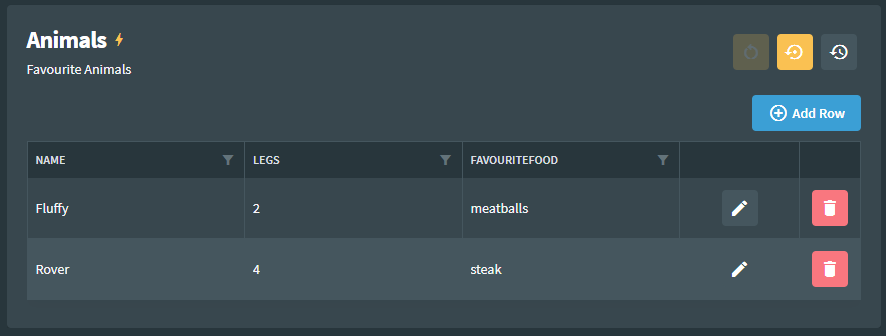Data Grids
Fig supports data grids for displaying complex settings.
Usage
The following setting will result in a data grid with 3 columns, one for each property within the class. Items can be added, removed or edited as required.
[Setting("Favorite Animals")]
public List<Animal> Animals { get; set; }
public class Animal
{
public string Name { get; set; }
public int Legs { get; set; }
public string FavoriteFood { get; set; }
}
You can also create a data grid from a list of base types, for example:
[Setting("Favorite Names")]
public List<string> Names { get; set; }
Locking Data Grids
Data grids can also be locked. This prevents rows being added or removed. Existing rows can still be edited. To lock a data grid, used the DataGridLocked attribute.
[Setting("Favorite Animals")]
[DataGridLocked]
public List<Animal> Animals { get; set; }
Internal Attributes
Some attributes can also be used on the internal class including MultiLine, ValidValues, Secret and Validation. These work in the same way that they do on regular properties. In addition, there is a ReadOnly attributes which makes that column read only when editing the data grid.
[Setting("Favorite Animals")]
public List<Animal> Animals { get; set; }
public class Animal
{
[ReadOnly]
public string Name { get; set; }
[ValidValues("1", "2", "3")]
public int Legs { get; set; }
[MultiLine(3)]
[Validation(ValidationType.NotEmpty)]
public string FavoriteFood { get; set; }
[Secret]
public string Password { get;set; }
// Note valid values must be set for List<string> within a data grid.
// Only List<string> is supported, not other enumerable types.
[ValidValues("A", "B", "C")]
public List<string> Items { get; set; }
}
Default Values
Data grids support default values but as they are complex objects, they cannot be specified within the attribute. To specify a default value, create a static class and reference it within the setting attribute. For example:
[Setting("Favorite Animals", defaultValueMethodName: nameof(GetAnimals))]
public List<Animal> Animals { get; set; }
public static List<Animal> GetAnimals()
{
return new List<Animal>()
{
new Animal
{
Name = "Fluffy",
Legs = 2,
FavoriteFood = "carrots"
},
new Animal()
{
Name = "Rover",
Legs = 4,
FavoriteFood = "steak"
}
};
}
Appearance
